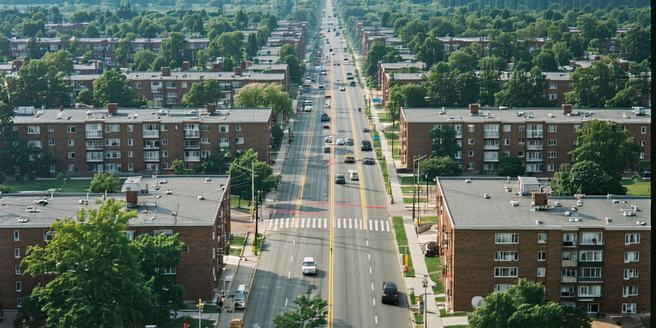Rent Stabilization: Historical Context And Outlook

The Origins of Rent Stabilization Policies
Rent stabilization policies emerged as a response to urban housing crises in the mid-20th century. Initially, they were introduced during World War II to control rampant rent inflation amid housing shortages. The policies aimed to protect tenants from sudden rent increases while ensuring housing affordability. In post-war years, cities continued to implement these controls to stabilize housing markets and prevent displacement. Rent stabilization became a tool for social equity by providing tenants with predictable rental costs. It also emerged as a means to combat homelessness, as soaring rents often lead to untenable living conditions. Over time, these policies evolved, reflecting changes in demographics, economic conditions, and housing markets. Understanding their origins sheds light on their effectiveness and the ongoing debates about their role in modern housing contexts.
Key Legislation and Developments Over the Decades
Throughout the decades, key legislation has shaped the landscape of rent stabilization. In the United States, critical legislative milestones included the 1947 enactment of the Housing and Rent Act which established federal rent controls, and the Rent Stabilization Law of 1969 in New York City, marking a significant shift towards local regulation. Over time, many jurisdictions allowed these regulations to lapse, but New York, Los Angeles, and San Francisco retained and adapted them. The continual evolution of these laws reflects responses to economic pressures, housing demand, and socio-political factors. Amendments often address loopholes or landlord-tenant disputes, demonstrating the challenges in balancing interests. These laws not only impact the rental market but also influence urban development, neighborhood stability, and economic diversity within cities.
Impact of Rent Stabilization on Tenants and Landlords
Rent stabilization policies are intended to protect tenants by ensuring housing affordability and stability. For tenants, stabilized rent means reduced vulnerability to market fluctuations, enabling long-term residency and community continuity. However, for landlords, these policies can limit investment returns and complicate property management strategies. Critics argue that such controls may deter new construction by reducing potential profits, thus contributing to housing shortages. Conversely, advocates claim these measures help prevent displacement and promote socioeconomic diversity. The policies often lead to a strained relationship between tenant rights and property rights, necessitating effective mediation and regulation. Ultimately, the impact of rent stabilization varies based on implementation, local market conditions, and enforcement, influencing the dynamics of urban living and housing availability.
Comparing Rent Stabilization Across Different Cities
Rent stabilization is implemented distinctively across various cities, reflecting diverse housing markets and policy priorities. In New York City, rent stabilization covers a significant portion of rental units, providing strong tenant protections but also sparking debates over housing scarcity. Conversely, in Los Angeles, rent stabilization laws focus on limiting rent increases and ensuring fair eviction practices, addressing high rental costs and homelessness. San Francisco’s approach combines rent control with eviction regulations to protect tenants, yet faces criticism for exacerbating housing shortages. Internationally, cities like Berlin and Stockholm have similar controls, focusing on social housing and affordability. These differing frameworks highlight the complexity of balancing tenant needs with market dynamics, illustrating the need for tailored solutions that consider local housing trends and economic conditions.
Critiques and Praise: Diverse Perspectives on Rent Limits
Rent stabilization policies are widely debated, attracting both praise and criticism from various stakeholders. Proponents argue that such policies are crucial in curbing rent spikes, safeguarding affordable housing, and promoting community stability. They emphasize the role of rent limits in preventing homelessness and ensuring demographic diversity in urban centers. Conversely, critics contend that these measures distort market dynamics, dissuading new construction and limiting rental housing supply. They argue that restrictive regulations stifle investment, leading to deteriorating property conditions. Some economists suggest that while rent stabilization helps current tenants, it may inadvertently harm future renters due to reduced housing availability. These diverse perspectives underscore the intricacy of balancing housing affordability with market health, emphasizing the necessity for nuanced policy-making.
Future Predictions and Policy Considerations for Rent Stabilization
The future of rent stabilization is shaped by economic shifts, housing demand, and legislative trends. Rising urban populations and affordability concerns are likely to sustain the call for rent controls. However, policymakers must navigate the tension between protecting tenants and encouraging housing development. Future approaches could involve combining rent stabilization with incentives for new construction to expand supply. Technological advancements in housing data may enhance policy precision, while academic research can inform best practices. Local governments might also consider regional cooperation to address cross-border housing issues effectively. As climate change impacts urban living, sustainable practices could be integrated into housing policies. Predicting future trends entails balancing diverse needs, ensuring tenant protection, fostering economic vitality, and adapting to global challenges reshaping housing demands.